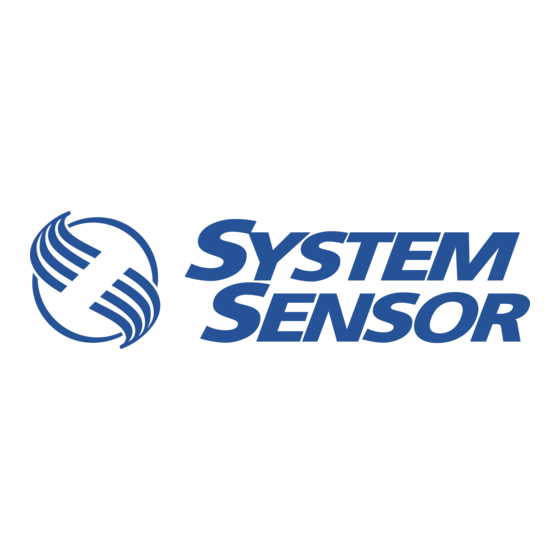Table of Contents
Advertisement
Quick Links
INSTALLATION AND MAINTENANCE INSTRUCTIONS
2112TL Photoelectronic
Smoke Detector
Specifications
Diameter:
Height (including mounting bracket):
Weight:
Operating Temperature Range:
Operating Humidity Range:
Latching Alarm:
Heat Sensor:
Electrical Ratings
System Voltage
Maximum Ripple Voltage:
Alarm Current (at 12 V):
Reset Voltage:
Reset Time:
Start-up Time:
Before Installing
Please thoroughly read System Sensor manual I56-407,
Guide for Proper Use of System Smoke Detectors, which pro-
vides detailed information on detector spacing, placement,
zoning, wiring, and special applications. Copies of this
manual are available at no charge from System Sensor.
NOTICE: This manual should be left with the owner/user
of this equipment.
IMPORTANT: This detector must be tested and maintained
following NFPA 72 requirements. The detector should be
cleaned at least once a year.
General Description
The Model 2112TL is a 4-wire photoelectronic smoke detec-
tor that uses a state-of-the-art optical sensing chamber.
This detector is designed to provide open area protection. It
features restorable, built-in, fixed-temperature (135° F)
thermal sensors.
D200-66-00
5.5 inches (140 mm)
1.7 inches (43 mm)
5.3 oz. (150 g)
32° to 100° F (0° to 37.7° C)
10% to 93% relative humidity, noncondensing
Reset by momentary power interruption
135° F fixed temperature electronic thermistor
Nominal:
12 VDC
Minimum:
9.5 VDC
Maximum:
14 VDC
30% of nom. voltage (peak to peak)
13 mA maximum
0.8 VDC minimum
0.3 seconds maximum
30 seconds maximum (after 30 second reset)
Installation of this detector is simplified by the use of the
mounting bracket and plug-in screw terminal block that
can be prewired to the system, allowing the detector to be
easily installed or removed for cleaning.
The 2112TL features transistors that provide alarm, power
supervisory, and sensitivity status signals for complete
smoke detector performance.
NOTE: The alarm and supervisory outputs are not to be
In addition, an LED on the detector provides a local visual
indication of the detector's status. If power is applied to the
detector, and it is functioning normally in standby, the sta-
tus LED blinks every ten seconds. The LED latches on in
alarm and quits flashing when the detector deviates from
its sensitivity range.
1
3825 Ohio Avenue, St. Charles, Illinois 60174
1-800-SENSOR2, FAX: 630-377-6495
used as relay contacts.
A Division of Pittway
I56-997-02
Advertisement
Table of Contents

Summary of Contents for System Sensor 2112TL
-
Page 1: Smoke Detector
If power is applied to the General Description The Model 2112TL is a 4-wire photoelectronic smoke detec- detector, and it is functioning normally in standby, the sta- tor that uses a state-of-the-art optical sensing chamber. - Page 2 A78-2563-00 lowed for the control panel being used before wiring the detector loops. Mounting The 2112TL detector is supplied with a mounting bracket Wire connections are made by stripping about inch of that permits the detector to be mounted: insulation from the end of the feed wire, inserting the wire 1.
- Page 3 Figure 3. Wiring diagram for the 2112TL detector: POWER DETECTORS – (See Note 1) UL LISTED EOL RESISTOR CONTROL SPECIFIED BY PANEL PANEL MANUFACTURER Power Supervision INITIATING LOOP – OPTIONAL CLASS A WIRING A78-2336-04 Note1: This terminal is not electrically connected to the detector's circuit.
- Page 4 NFPA 72 or at least once a year. Three-Year Limited Warranty System Sensor warrants its enclosed smoke detector to be free from de- ment, RA #__________, 3825 Ohio Avenue, St. Charles, IL 60174. Please fects in materials and workmanship under normal use and service for a include a note describing the malfunction and suspected cause of failure.












Need help?
Do you have a question about the 2112TL and is the answer not in the manual?
Questions and answers